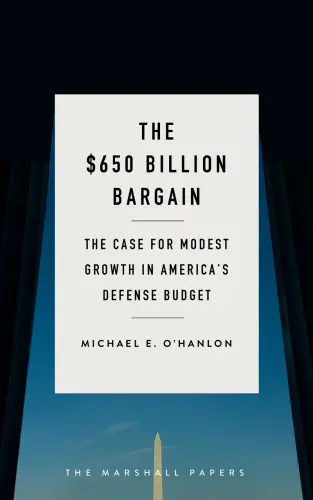After two years of unified Republican rule, a divided Congress—with Democrats in the House of Representatives majority and Republicans in the Senate majority—will now be responsible for managing the nation’s pocketbook. Importantly, that includes figuring out how to pay for the United States’ increasingly complex and expensive defense priorities. On November 20, the Foreign Policy program at Brookings hosted an expert panel moderated by Senior Fellow Michael O’Hanlon to assess the post-midterm outlook for the defense budget.
Brookings Senior Fellow Elaine Kamarck laid out the new political landscape the Department of Defense will soon face in Washington. Despite a generally more progressive ideological tilt to the Democratic Party since its last House majority from 2007 to 2011—and ahead of changes in defense committee leadership—Kamarck assessed that the House is not likely to spearhead a big debate about large cuts in defense spending. Rather, she contended, it will likely focus on greater oversight over national security policy decisions and personnel.
The power of the purse
Maya MacGuineas, president of the Committee for a Responsible Federal Budget, discussed the United States’ overall fiscal health and how it will affect defense spending trends. She explained that the United States is on the precipice of trillion-dollar annual budgets, which is unusual given that the U.S. economy is currently growing strongly. Because the national debt relative to the federal budget is the highest it’s been since World War II, the federal government now has fewer tools at its disposal to combat the next recession, which she said is likely to take place in the next few years.
MacGuineas noted that a number of senior national security leaders have previously warned that the debt is itself a significant national security challenge. The United States’ worsening trade outlook with China, which finances a significant amount of U.S. debt, makes the nation’s fiscal health an even greater security vulnerability. MacGuineas argued that “if in the defense budget we decide something is worth doing, then we decide it’s worth paying for,” which she noted is best achieved by returning to regular order in the budgeting process. While she did not advocate for specific cuts in defense spending, MacGuineas noted that a serious commitment to getting the national budget under control requires putting everything on the table for discussion, including outdated or unnecessary defense outlays.
Determining defense priorities
Jim Miller, former undersecretary of defense for policy, opened his remarks by praising Defense Secretary James Mattis for articulating a new national defense strategy that gives principal focus to great power competition. He noted that the strategy’s shift away from longstanding counterinsurgency operations—which began under President Obama—requires that the United States invest adequate resources in devising a force capable of deterring and countering Chinese and Russian power.
Miller proposed a number of budgetary tradeoffs for policymakers to consider. One is current operations versus future operations, where future operations incorporate both readiness and modernization. The second is thinking about capacity versus capability, or quantity versus quality—and here, Miller argued that the Department of Defense should devote more resources to investing in research and development to ensure the United States retains an edge in key competitive areas. The third tradeoff he noted deals with specific capability areas—in particular, he singled out recapitalizing the nuclear triad through modernization. Miller concluded that even with the right tradeoffs, the United States must still prioritize within the defense budget.
However, considering the cost of defense to the national economy—close to 4 percent of GDP, including contingency operations—Miller believes the United States can afford it as long as policymakers spend taxpayer dollars wisely and focus on the great power competition articulated in the latest National Defense Strategy document.
O’Hanlon asked Miller if he’d be comfortable with the possibility of a $700 billion national budget in 2020—a figure that has been recently been referenced by Office of Management and Budget Director Mick Mulvaney and National Security Advisor John Bolton—which is about $33 billion less for that year than was expected. Miller replied that he could tolerate that figure while cautioning that if the United States is to have a strategy-driven budget, the Department of Defense must emphasize the capabilities that support that strategy. O’Hanlon also referenced proposed growth trends in the force structure—e.g. the Navy wants 355 ships, and the Army wants to grow to 500,000 active soldiers—and Miller agreed that these figures have to be rethought if the United States has to make tough budgetary choices given the strategic environment and reductions in expected defense spending.
The politics of strategic defense issues
O’Hanlon then asked Frank Rose—senior fellow at Brookings and former assistant secretary of state for arms control, verification, and compliance—to discuss the defense budget outlook on strategic issues.
Rose cautioned that in the upcoming Congress, there will be a fair amount of friction between House Democrats and the Trump administration on strategic matters. During the Obama administration, Rose explained there was bipartisan consensus on the need to modernize the nation’s strategic nuclear delivery vehicles and infrastructure, but that consensus is now beginning to fray. One of the reasons for the fraying of consensus is the potential price tag of the modernization program, which Rose noted—citing the Congressional Budget Office—could cost $1.2 trillion over the next 30 years. Another reason is the Trump administration’s call in the latest Nuclear Posture Review for new low-yield capabilities, which has generated significant pushback from some congressional Democrats. Finally, Rose explained that the fraying of bipartisan consensus on nuclear modernization is partly attributable to Democrats’ belief that the Trump administration is hostile to the very idea of arms control. Rose concluded that if New START is not extended with Russia before it expires in 2021, the Trump administration will have a very difficult time maintaining any bipartisan momentum for strategic modernization.
On space security, Rose pointed out that because Russia and China are developing a full range of anti-satellite capabilities to deny the United States access to space-derived information, President Trump’s Space Force idea isn’t as crazy as it sounds. However, because Trump made it a partisan issue—announcing it at a campaign rally, for instance—he will find it difficult to persuade Democrats in the new Congress to fund it. Finally, on missile defense, Rose said that despite the problem of Russian and Chinese strategic missile capabilities, there is unlikely to be much support for space-based missile defenses among incoming Democratic House majority.




Commentary
How will the new Congress approach the defense budget?
Experts discuss
November 28, 2018